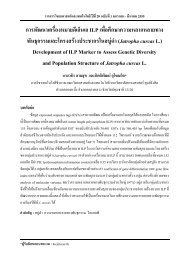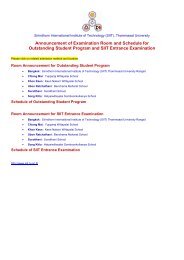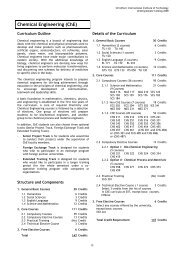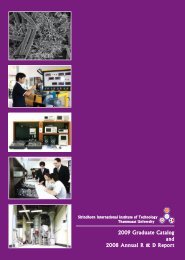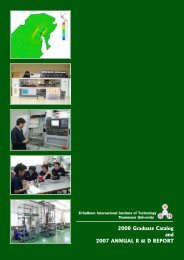2005 Graduate Catalog and 2004 Annual R & D Report - Sirindhorn ...
2005 Graduate Catalog and 2004 Annual R & D Report - Sirindhorn ...
2005 Graduate Catalog and 2004 Annual R & D Report - Sirindhorn ...
- No tags were found...
Create successful ePaper yourself
Turn your PDF publications into a flip-book with our unique Google optimized e-Paper software.
<strong>2005</strong> <strong>Graduate</strong> <strong>Catalog</strong> <strong>and</strong> <strong>2004</strong> <strong>Annual</strong> R & D <strong>Report</strong><br />
<strong>Sirindhorn</strong> International Institute of Technology (SIIT)<br />
Dr. Komwut Wipusitwarakun<br />
Assistant Professor (Half-time)<br />
B.S. (2 nd Class Honors) in Electrical Engineering, Chulalongkorn University, Thail<strong>and</strong><br />
M.S. in Communication Engineering, Osaka University, Osaka, Japan<br />
Ph.D. in Communication Engineering, Osaka University, Osaka, Japan<br />
Areas of Specialization: Broadb<strong>and</strong> communication networks, Network reliability analysis, Self-healing network<br />
design, ATM <strong>and</strong> TCP/IP technologies, Congestion control technologies.<br />
Research Interests:<br />
Highly Reliable Wide Area Network Design<br />
In the coming “Information Age”, business <strong>and</strong> daily<br />
life will be highly reliant on telecommunication<br />
services. All organizations, companies <strong>and</strong> ordinary<br />
homes will be connected together by the Wide Area<br />
Communication Networks (WAN) so that various<br />
kinds of services, provided at anywhere, can be<br />
accessible from everywhere at anytime. Network<br />
reliability will become a vital concern since the failure<br />
of network functionality will result in a significant<br />
impact on a wide-range of users both in tangible <strong>and</strong><br />
intangible forms. Thus, technologies for designing<br />
<strong>and</strong> assuring the high reliability of WAN are needed.<br />
These include, for example, theory <strong>and</strong> tools to<br />
analyze the reliability-level of networks, automatic rerouting<br />
algorithms (self-healing algorithm) design,<br />
reliability-level based traffic prioritizing scheme,<br />
working <strong>and</strong> spare capacity design <strong>and</strong> plans to<br />
upgrade reliability-level of existing networks, etc.<br />
Virtual Private Network<br />
The Virtual Private Network (VPN) is technology to<br />
enhance the utilization of an unreliable connection<br />
traversing through public networks (either circuitswitching-based<br />
or IP(Internet Protocol)-based<br />
network) <strong>and</strong> sharing b<strong>and</strong>widths with other users to<br />
create a reliable/secured connection (virtual private<br />
connection) like a conventional leased circuit, but with<br />
much lower costs. The IP-based VPN is promising<br />
since IP-based applications are widely used in all<br />
communities. The IP-based VPN technology involves<br />
designing a security scheme to protect transferred<br />
data from other users, a b<strong>and</strong>width management<br />
scheme to retain the acceptable b<strong>and</strong>width-level of<br />
the connection <strong>and</strong> a parallel data-transferring<br />
scheme to create a virtual high-b<strong>and</strong>width connection<br />
from a group of low-b<strong>and</strong>width connections.<br />
Dr. Matthew N. Dailey<br />
Lecturer<br />
B.Sc. & M.Sc. in Computer Science, North Carolina State University, USA<br />
Ph.D. in Computer Science <strong>and</strong> Cognitive Science, University of California, San Diego, USA<br />
Areas of Specialization: Machine Learning, Machine Vision, Robotics.<br />
Research Interests:<br />
Structure Learning for Autonomous Mobile<br />
Robots<br />
Intelligent systems <strong>and</strong> robotics technology together<br />
st<strong>and</strong> poised to revolutionize the way human beings<br />
live <strong>and</strong> work, thanks in large part to the increasing<br />
availability of enormous quantities of computing<br />
power at very low cost. But despite great advances in<br />
mechatronics, when compared to humans (or even<br />
rats), modern technology is deficient in the<br />
perception of the surrounding environment.<br />
Today's robots cannot see much better than the<br />
simplest insects.<br />
Machine vision research aims to close this crucial<br />
gap, but thus far, we have only rudimentary<br />
algorithms for inferring the 3D structure of the world<br />
from one or more moving cameras. New<br />
developments in statistical learning, however, have<br />
already transformed many areas of artificial<br />
intelligence, <strong>and</strong> promise to transform machine vision<br />
research in the same way.<br />
The general framework of my research is to<br />
1) formulate 3D structure learning problems as<br />
problems of statistical inference, 2) specify statistical<br />
models appropriate for the problem at h<strong>and</strong>, <strong>and</strong> 3)<br />
devise efficient algorithms for inference under said<br />
statistical models. One example in my current work is<br />
Bayesian estimation of feature correspondences in<br />
trinocular stereo images. In stereo, the goal is to find<br />
corresponding features in two or more cameras (three<br />
cameras in the case of trinocular stereo) with known<br />
calibration parameters. Then, we use triangulation to<br />
determine the distance to the identified feature. Once<br />
a robot knows which points correspond to each other<br />
in a set of images, it can construct a 3D<br />
representation of the nearby environment. But finding<br />
these correspondences is a challenging problem, <strong>and</strong><br />
current existing approaches are not accurate enough,<br />
robust enough, or efficient enough for real-time use<br />
by autonomous mobile robots. I believe that the<br />
statistical learning approach will lead to new, effective<br />
solutions to this <strong>and</strong> other difficult problems in robot<br />
visual perception.<br />
25




